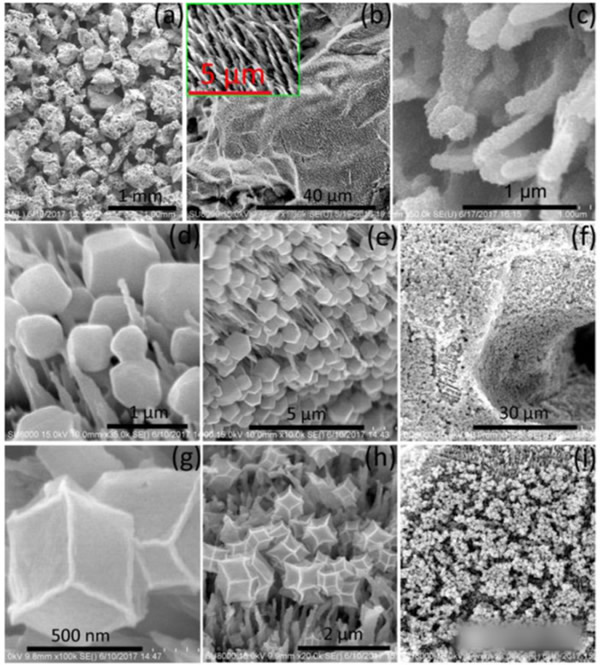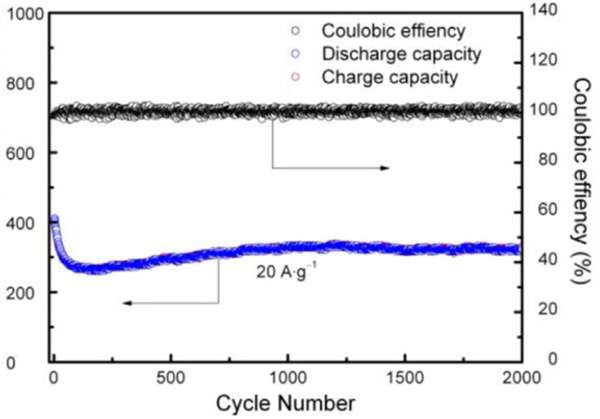30C ultra high magnification cycle 2000 times no decline in capacity! MOFs process boost super
At present, the development of the power battery can be mainly divided into two directions: 1) high specific energy direction; 2) fast charging direction, although under the current subsidy policy for new energy vehicles, high specific energy batteries have become the main power battery manufacturers research direction. However, while improving the specific energy of lithium-ion batteries, we also need to continuously improve the charging characteristics of lithium-ion batteries. Lithium-ion battery's charging ability is mainly affected by the negative dynamic characteristics. The traditional graphite negative electrode has poor dynamic characteristics. It is easy to cause the precipitation of metal Li on the surface of the negative electrode during rapid charge. At the same time, the theoretical specific energy of graphite negative electrode is only 372mAh. /g, it is difficult to meet the design requirements for high specific energy and fast-charging batteries. The transition metal oxide anode material prepared by MOFs method has a small particle size and a large number of micropores, which significantly improves the material's performance. Magnification performance has become one of the best choices to solve this problem.
Recently, Guangyu Zhao of Harbin Institute of Technology used the electrochemically-assisted MOFs method to synthesize Co3O4 material on a Ti nanowire substrate. The electrode exhibited excellent rate performance and cycling performance. At an ultra-high rate of 20 A/g, the electrode still remains. The capacity of 300 mAh/g can be exerted, and there is no significant capacity drop during 2000 cycles, and it is of great significance to develop a lithium ion battery having both high specific energy and fast charge characteristics at a current density of 1 A/g.

The thin film material prepared by the MOFs method generally has poor adhesion to the substrate. To solve this problem, Guangyu Zhao uses a Ti foil with a vertical Ti nanowire structure as a substrate, and then the precursor of the MOFs process is electrochemically deposited. On the above-mentioned substrate (the synthesis process is shown in the figure above), this not only enhances the adhesion between the substrate and the precursor, but also ensures good electronic conductivity, thereby greatly improving the rate performance of the material.
The morphology of the Co3O4/Ti electrode prepared by the above process is shown in the following figure. After 600 s deposition at -2.0 V, we can see that the surface of the Ti nanowires is covered with a layer of nanoparticles (as shown in the following figure c) after XRD. Crystal structure analysis of these nanoparticles is metal Co, and then through the MOFs process the zeolite imidazole metal organic framework material ZIF67 deposited on the Co/Ti composite structure, at this time we can observe some polyhedral MOFs at the top of Ti nanowires, At the same time, we also noticed that the surface of the Ti nanowires has become smooth at this time, indicating that Co has been consumed during the deposition of ZIF67 (as shown in Figure d below). Then the above precursors were pyrolyzed. From the following figures g, h, and f, we can see that the pyrolysis-generated Co3O4 still maintains the morphology of the precursors, uniformly dispersed on the Ti nanowires, and is uniformly distributed on the Ti nanowires. The wire is firmly fixed. The characteristics of this self-supporting structure determine that it does not require a binder and a conductive agent, and good dispersion properties significantly improve the material's rate performance.

In the following electrochemical performance tests, Co3O4/Ti structure electrodes exhibited excellent rate performance and cycle stability as expected. From the rate performance test results shown in the following figure, we can see that the Co3O4/Ti electrode prepared by the above process (see a below) can exert a capacity of 700 mAh/g at a current density of 1 A/g, even if the current density is increased to At a staggering 50A/g, the material can still exert a specific capacity of 180mAh/g. On the contrary, the Co3O4 material deposited on a smooth Ti substrate with the same MOFs process has very poor rate of magnification (below b), at the current density. After reaching 5A/g or more, it is almost impossible to exert the capacity, and Guangyu Zhao believes that this may be due to the poor dispersibility and cohesiveness of Co-MOFs prepared by the conventional MOFs process on the Ti foil substrate.


The figure below shows the cycling performance of a Co3O4/Ti electrode prepared using a Ti nanowire matrix. From the figure, we can see that the cycle is 2000 times at a charge-discharge rate of 20 A/g, and there is almost no capacity degradation of the Co3O4/Ti electrode. The main benefit is that the Ti nanowire structure not only firmly immobilizes the Co3O4 particles, but also provides good electronic conductivity. In addition, the good dispersion of Co3O4 greatly reduces the diffusion resistance of Li+ and improves the cycle performance of the electrode. .

The preparation process developed by Guangyu Zhao uses the Ti nanowire matrix to well solve the problems of poor adhesion between the film and the substrate prepared by the MOFs process, and poor cycling performance and rate performance caused by uneven dispersion of the active material of the film. The wire firmly holds Co3O4 on the substrate and also provides highly efficient electron transfer channels. In addition, the good dispersibility of Co3O4 particles on the substrate reduces the diffusion resistance of Li+. This helps the Co3O4/Ti material to achieve an amazing magnification. Performance, the capacity can reach 700mAh/g under the current density of 1A/g, can still exert the capacity of 180mAh/g under the current density of 50A/g, more importantly this material is under the current density of 20A/g The charge-discharge cycle was 2000 times, and there was almost no loss of capacity. This made it possible for lithium-ion batteries with high specific energy and fast charge characteristics.
Led Illuminated Mirror Light,Over Mirror Light,Decoraport Led Mirror,Rgb Led Strip
NINGBO EASTKEY ILLUMINATE APPLIANCE CO.,LTD , https://www.eastkeylighting.com